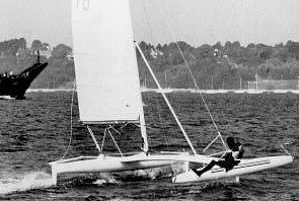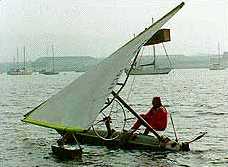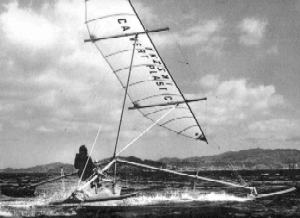Mr Smith's Amazing Sailboats
Full-Sized Craft
by Other Designers
Here we look at full-sized
(ie-crewed) craft that share a link to the designs of Bernard Smith. Some of the
sailing machines featured here are inspired directly by Bernard's work. Other craft,
however, have quite different origins, and are included because they have certain design
features in common with Bernard's designs, such as having sails and foils both inclined to
windward.
This selection of craft is by no means complete - if you know of other designs worthy of
inclusion please email
aerohydro.
Ralph Gitomer's Fliptacker
A patent examiner from Virginia, USA,
Ralph was Bernard Smith's most recent collaborator, working together on the fliptacker
concept. Ralph went on to create and test a number of fliptacker sailboats, the
image below is of his final design. Further information, plus several photos, are to
be found here. Ralph can also be
contacted by email.

Bob
Imhoff's Aero-Hydrofoils
Californian inventor Bob Imhoff was inspired by Bernard Smith's work to create his own
craft, which feature buoyant foils and a double-surfaced wing-sail. Detailed information
about Bob's designs, along with several photos, can be seen here.

Seaflier
A reversible proa
featuring a wingsail and arched hydrofoils! A very exotic and beautiful looking
design dating from the mid-80s, the Seaflier was designed by the late Patrick Cudmore of Boston,
and was just one of a series of craft he had developed. More information about the
Seaflier, including other images, can be found here.

This craft was the brainchild of Ned Snead and might be considered to be a variation of the Monomaran III design, but one which uses slender displacement hulls instead of foils. A Texan inventor, Ned was joined for a while by Malcolm Barnsley in developing the concept. The image below shows a version of the Delta (with two-way airfoils on the spars) being sailed in a Texan speed event. Malcolm later sailed the boat in speed trials at Weymouth, UK. More details are here.

A one-way proa with foils and sail both inclined to windward. Developed and tested in Latvia, USSR by Aldis Eglajs in the early 1980s. Recorded a top speed of 27 knots - then an unoffical class record. More details can be found here.

A reversible hydrofoil proa, designed by Scandinavian marine architect Leif Wagner Smitt and campaigned briefly in speed sailing trials in 1972. Incorporate a canted rig into the design and the Kotaha would be, for all the world, an Aerohydrofoil. Look here for more information.

A sailing canoe enthusiast, Robert recently has come up with a number of Bernard Smith-inspired designs. Two of his concepts, based around the fliptacker, are fully detailed here.
A third - and quite ingenious - design, the Swingtacker, can be seen here.

Originally inspired by "The 40-knot Sailboat", Didier Costes of Paris, has developed the "Exoplane" series of sailing craft, all long sender proas, equipped with an inclined rig and a small stabilizer. The first designs, dating from the 70s, used small planing floats to stabilize the craft. Didier's recent examples - like this 1996 model - now use hapas, or curved hydrofoils, instead. More information can be found here. (Photo courtesy of Fiona Sinclair, AYRS.)

Another Frenchman, Jean Hurtado, created a fliptacker-like craft in the mid-90s. Both the hull and the sail rotated 90° when tacking. A single hull from a Nacra 5.5 catamaran is used - the sail is a very low aspect ratio affair, restricting high performance to strong wind conditions. Look here for more details. (Photo courtesy of Fiona Sinclair, AYRS)

A high-profile and money-rich project from the late 80s, this was the baby of yacht designer Jean Marie Finon and Whitbread sailor Lionel Péan, their goal being to each speeds of 100 km/h or 62 mph. Objectif 100 was a very fliptacker-like craft as it had a inclined wingsail rig tipped with hydrofoils and attached to a long slender hydrofoil-mounted hull. Although speeds of 30 knots were reached, development effectively stopped when the sponsor Rhône Poulenc withdrew their support. A few details about the craft can be found here, where you can also access photos and an explanation of how the craft worked.
Aerohydrohull
Designed by John
Goodwin of South Africa, circa 1967, this design blended attributes of the
aerohydrofoil with those of the conventional displacement hull. The main
hull was some 20+ ft long. Reports on this design can be found in AYRS
publications #62 and #66. At the time John Goodwin wrote that "first
results were promising, but after a few days sailing in light winds a
violent gale sprung up and the airfoil was broken at moorings. The airfoil
cannot reef and I am considering how best to overcome this fault..."
Click here to see a 750
pixel wide image of the Aerohydrohull. Thanks to Robert Biegler for
this information.

Designed by D Baverstock, the Aquaruis was built and tested in New Zealand in the early 1980s for a speed sailing event in Wellington Harbour. Included in an appendix to Marchaj's book , "The Aero-Hydrodynamics of Sailing", it was also mentioned in "Sailloons and Fliptackers". This craft might be considered a one-way version of the early monomaran concept. A future iteration of this site may include further details and photographs.
